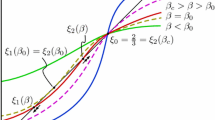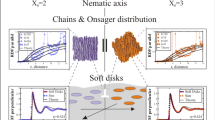Abstract
The pseudo-molecular method is employed to obtain analytical expressions for the elastic constants of an ensemble of anisotropic particles, in both disc-like and rod-like geometries. These particles interact via a phenomenological pair potential constructed from the non-spherical correction to the dispersion forces between two identical molecules. The molecular shape appears in the calculations of the elastic constants in two different cases. The first case considers a molecular volume of ellipsoidal shape continuously deformed from a positive (prolate spheroid, rod-like molecule) to large negative (oblate spheroid, disc-like molecule) values of a parameter describing some kind of eccentricity. The second one considers a molecular volume shape continuously deformed from a cylinder (calamitic molecule) to a plane disc by changing the ratio between the diameter of the cylinder and its long axis. The particular cases of Maier-Saupe and Nehring-Saupe interactions are obtained as simple limiting cases of the general pair potential interaction. These general results may be helpful to understand the limits of the pseudo-molecular method, and to understand the origin of elastic constants in discotic liquid crystals from a molecular perspective.








Similar content being viewed by others
Notes
It is assumed L = 0 in the nematic phase. In this case, there is no deformation in the ground state. L would be nonzero only in the cholesteric phase [1].
The value of C 1 will not be shown here, because when it is replaced in C i j k l , it yelds a vanishing contribution. In the following, we show that the elastic constants do not depend on C 1.
References
G. Barbero, L.R. Evangelista. An Elementary Course on the Continuum Theory for Nematic Liquid Crystals (World Scientific, Singapore, 2001)
J. Nehring, M. Saupe, J. Chem. Phys. 54, 337 (1971)
J. Nehring, M. Saupe, J. Chem. Phys. 56, 5527 (1972)
G. Vertogen, Physica A. 117, 227 (1983)
G Vertogen, W.H. de Jeu. Thermotropic Liquid Crystals, Fundamentals, Springer Series in Chemical Physics, vol. 45 (Springer, Berlin, 1988)
G. Barbero, L.R. Evangelista, Phys. Rev. E. 56, 6189 (1997)
G. Barbero, R. Barberi, in Physics of Liquid Crystalline Materials, eds. I.C. Khoo, F. Simoni (Gordon and Breach, New York, 1993)
G. Barbero, L.R. Evangelista, M. Giocondo, S. Ponti, J. Phys. II(4), 1519 (1994)
L.R. Evangelista, I. Hibler, H. Mukai, Phys. Rev. E. 58, 3245 (1998)
P.A. de Castro, J. Palangana, L. R. Evangelista, Phys. Rev. E. 60, 6195 (1999)
G. Barbero, L.R. Evangelista, S. Ponti, Phys. Rev. E. 54, 4442 (1996)
S. Ponti, F.C.M. Freire, J.C. Dias, L.R. Evangelista, Phys. Lett. A. 372, 6521 (2008)
P.S. Simonário, F.C. M. Freire, L.R. Evangelista, R.T. Teixeira-Souza, Phys. Lett. A. 378, 453 (2014)
B.C. Kohin, J. Chem. Phys. 33, 882 (1960)
S. Romano, Phys. Lett. A. 305, 196 (2002)
S. Romano, Mod. Phys. Lett. B. 15, 137 (2001)
R. Hashim, S. Romano, Int. J. Mod. Phys. B. 13, 3879 (1999)
G.R. Luckhurst, S. Romano, Liq. Cryst. 26, 871 (1999)
R.L. Humphries, G.R. Luckhurst, S. Romano, Mol. Phys. 42, 1205 (1981)
D. Apreutesei, G. Mehl, Chem. Commun., 609 (2006)
G de Matteis, S. Romano, Phys. Rev. E. 80, 031702 (2009)
S. Romano, Int. J. Mod. Phys. B. 12, 2305 (1998)
S. Romano, Int. J. Mod. Phys. B. 14, 1195 (2000)
D. Hilbert, S. Cohn-Vossen. Geometry and the Imagination (Chelsea Publishing, New York, 1952)
Y. Galerne, A.M. Figueiredo Neto, L. Liebert, Phys. Rev. A. 31, 4047 (1985)
M. Abramowitz, I.A. Stegun, Handbook of Mathematical Functions with Formulas, Graphs and Tables (Dover, New York, 1965)
K. Sokalski, TH.W. Ruijgrok, Phys. A. 113, 126–132 (1981)
M. Bates, Phys. Rev. E. 65, 041706 (2002)
Acknowledgments
The authors would like to thank L. R. Evangelista and R. T. Teixeira-Souza for comments and suggestions to improve the work, and the anonymous referee for suggesting a better redaction.
Author information
Authors and Affiliations
Corresponding author
Rights and permissions
About this article
Cite this article
Simonário, P.S., de Andrade, T.M. & Freire, F.C.M. Elastic Constants of a Disc-Like Nematic Liquid Crystal: Pseudo-Molecular Approach. Braz J Phys 46, 26–34 (2016). https://doi.org/10.1007/s13538-015-0375-2
Received:
Published:
Issue Date:
DOI: https://doi.org/10.1007/s13538-015-0375-2




